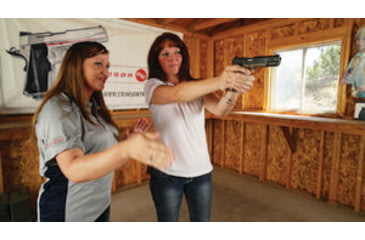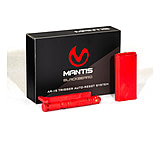What is Dry Fire?
Dry fire training is an effective and inexpensive way to practice the fundamentals of your shooting technique. In its simplest form, dry firing is target practice without the use of live ammo. You do everything as you would at the range except land shots on a target. Most experts agree that the main purpose of dry firing is to learn about your gun, examine your ability, and improve your technique before using live rounds on the range.![]()
Is It OK to Dry Fire?
You can safely dry fire most modern centerfire firearms. However, you should avoid dry firing with rimfire weapons since the firing pin is designed to hit the rim of the cartridge. Without a loaded round, the firing pin would strike the steel chamber, which can cause damage when done repeatedly. This is also true with some older gun models where the firing pin overextends without a cartridge in place.
Additionally, older single-action revolvers, especially ones popular among cowboy action shooters, can be damaged if fired with an empty chamber. Therefore, it's generally recommended to invest in snap caps. These inexpensive dummy rounds feature a soft spot in the primer to provide a cushion for the firing pin to strike. (Click here to learn more about snap caps and dummy rounds.)
Why Would You Dry Fire a Gun?
The goal of dry fire practice is to improve your shooting mechanics and aim without the use of ammunition. Not only does this help you save money, but it is a proven method to improve your shooting technique without the distractions that live fire presents. When firing live rounds of ammo, the sound of the gunshot and recoil from your firearm hinder your ability to fine-tune your skills. Without these distractions, you can focus solely on your sight picture and trigger squeeze to examine the foundation of your overall technique.
Dry fire training is also a safe practice method since ammo is not used. In fact, cartridges should be nowhere near your dry fire setup to prevent accidents and injury. Also, dry fire is not just pulling the trigger. There are several dry fire drills you can practice, like drawing, reloading, and target acquisition. In fact, dry fire drills can help improve almost every aspect of your shot besides recoil management, which can only be done with live rounds or certain dry fire training tools.
What Should Be Done Before Dry Firing?
Before you start your training exercises, you need to create a safe space to dry fire. The most important thing to do is to ensure your weapon is not loaded and perform a chamber check. You should actually remove all live ammo from the area to guarantee a live round won't be introduced to your weapon. Even though your weapon is unloaded, you should still treat it as if it is, including following the basics of firearm safety.
Find a Safe Place to Dry Fire
This can be a garage or an empty room without people or distractions nearby. Dry firing is done with a purpose, and having a TV or radio on can impact the effectiveness of your drills.
Set Up a Target Area
Once you have a safe space, an unloaded gun, and a training plan, the last thing to do is to set up something to shoot at. Taping a target to the wall or simply using a sticky note will suffice. You just need something to aim at.
How Can You Improve Your Dry Fire Drills?
In tactical training, you often hear the expression "slow is fast and fast is slow." That means a smooth and proper application of technique is better than speed. Most shooting instructors recommend you start dry fire training with a steady, slow pull. Pulling the trigger slowly will reveal so much about the firearm. You'll learn:
- How much pressure you need to apply to set off the gun
- How much slack is in the trigger
- When the trigger engages the firing mechanism (or hits the "wall")
- How much the trigger "creeps" to the breaking point
Following that same line of thought, most instructors will also recommend you control the trigger reset. During dry firing, this means keeping the trigger depressed when you recharge the gun. With a controlled reset, you'll feel the springs loosen as you slowly ease the trigger forward. Then, you'll hear and feel the trigger click. In short, this dry run will help you understand the mechanics of your gun and basic trigger control.
Dry Fire Training Gear
If you have some room in your budget, there are several dry fire training systems available that can create a more efficient and fun experience. A laser training handgun may be used with targets to show your point of impact, creating more thrilling and rewarding exercises. There are even laser training pistols with recoil that can help you practice managing your recoil without the use of live fire.
How to Dry Fire at Home
By now, you understand the basic idea of what dry firing is, so it's time to discuss how to do it.
In general, dry fire training involves drawing, presenting, aiming, and shooting your gun, but more importantly, it's about analyzing and improving each of those aspects.
Take It One Step at a Time
Focusing on individual steps is the most efficient way to dry fire. Pay attention to how you grip your gun, focus on your target, draw your weapon, and pull your trigger. By tuning in to each separate element of your shot, you can drastically improve problem areas and boost your overall technique when the steps are combined.
Movement Matters
Moving without moving your sight picture is an excellent way to practice your dry fire technique.
You want to stay on your gun and within your sight picture without moving even after the shot is taken. From there, you can perform an after-shot assessment. After you pull the trigger, you should freeze and note where your sights are in relation to your target and then compare them to your starting position, which should be center mass.
Finger Placement
Working on your trigger finger placement is another important aspect of dry practice. If you have too much or too little finger on the trigger, it will pull shots away from your intended aiming point. Most experts agree that the ideal trigger finger placement is about one-third out from your first knuckle. From there, focus on a straight, smooth trigger pull.
Dry Fire Shooting Tips
Dry firing is a technique used by many professional marksmen and is the best way to practice your skills without using live ammunition. Dry fire drills will help you improve your muscle memory and sight alignment while also teaching you a proper grip. Check out our Dry Fire Practice guide for more tips on how to properly dry fire, and use these tips to have a safe and fun training experience!






